Mario is Missing!
Template:Infobox Mario was Missing! was an educational game created for MS-DOS, the SNES and the NES. The gameplay was widely panned by the critics, although it's Super Mario World music remixes gained recognition. Mario was Missing! was released in floppy disk format for MS-DOS in 1992 with the CD-ROM Deluxe edition and console versions released the following year. A follow-up called Mario's Time Machine was eventually produced. This was the first game where Luigi was the main protagonist with Mario in a supporting role and one of the only two solo adventures for Luigi (The other being the Nelsonic Game Watch game Luigi's Hammer Toss) until 2001 when Luigi's Mansion was released on the Nintendo GameCube.
Story
Bowser decided to flood the Earth by using the hairdryers from Hafta Havit Mail-Order to melt Antarctica. In order to buy the hairdryers, Bowser had his Koopa Troopas travel all over the world and steal various important landmarks that he planned to sell.
Mario, Luigi and Yoshi followed Bowser to Antarctica to stop him, but when Mario went on ahead, he was captured by Bowser. The PC version was the most elaborate: Luigi was too scared to go inside the castle so Mario entered alone. Despite Luigi's warnings against taking candy from strangers, Mario ate some candy that was offered to him by Bowser (Disguised as a butler) and was scooped up in a net. In the SNES version, Mario arrived last in Antarctica (Luigi and Yoshi are already present and Mario was apparently warped to Antarctica by accident while he was distracted by the incomplete title in Dinosaur Land) and Luigi even seemed eager to go into the castle after appreciating that Mario "dropped in." with a pit opening up beneath him when the group reached the castle while in the NES version, a Koopa threw a bag over Mario while he was fuming about the title claiming that he was missing as he walked through the snow and ice.
With Mario captured, the task of returning all of the stolen artifacts and saving both his brother and Earth fell to Luigi who bravely entered the castle, leaving Yoshi outside.
Story from console instruction booklet
Bowser's Plot
Oh no! Bowser and his bad boys are back to a life of crime. This time, it was not Mario World. It was your world! From his Antarctic castle, Bowser hustled his cold-blooded crew of cantankerous Koopas into his powerful Passcode Operated Remote Transport And Larceny System (PORTALS). The twisted turtles transported themselves throughout the globe where the celebrated cities suffered from shell-shocking crime waves as the turtles trashed the landmarks and looted the ancient artifacts. With dough from his slimy scales, Bowser hoarded the hair dryers from the Hafta-Havit Hotline. His plot? Melt Antarctica and flood the planet! Whoa!
Mario's Fate
Would the brave brothers from Brooklyn permit this abominable snow plan? The boys said "Not!" Mario, Luigi and Yoshi trekked across ice and snow to shellac the shelled ones' schemes. But, Bowser was slick. In one last trick, he took the dearest thing of all.Mario was Missing!
Luigi's Mission
Luigi must stop the Koopas, foil Bowser's plan and find Mario. Sneaking into each Portal, Luigi was transported to a city in trouble. There, Luigi needed to nab each Koopa, grab it's loot and return the artifact to it's proper landmark. Along the way, Luigi explored the city, chatted with the locals, readed the maps and solved the puzzles. Help him do this before the time ran out! Once he figured out where he was on the globe,
Luigi must use the Globulator to call Yoshi. Only after Yoshi scared Pokey away, Luigi could return to Bowser's castle and lock the Portal for that city.
Ending
In the DOS version, Luigi took Bowser's shell (Which covered his tail in this depiction) off, causing Bowser to run off screen, embarrassed about his polka-dot boxers. This was the only time that Bowser was seen in his shell-less form. Luigi shook the shell to retrieve the key to Mario's cell and threw the carapace away. Bowser returned wondering where his shell was. Luigi lied to him by saying that he threw the shell off the balcony. When Bowser leaned over the railing to look for it, Luigi kicked him off and he landed in the snow. Luigi opened Mario's cell and the two danced around in joy. They went outside and shook Yoshi's hand before walking off into the distance together. Bowser poked his head out of the snow, looking in their direction with his shell back on.
In the Macintosh version, Bowser did not run off after his boxers are revealed and Luigi smacked him off the balcony with his own shell.
In the SNES version of the ending, Luigi pulled a lever to reveal Mario behind a wall. Bowser jumped down from a distant ledge, but Luigi pulled the same lever, causing Bowser to fall down into a cannon. He was launched out of the castle and into the snow where he froze instantly and shattered. In the NES version, Luigi and Bowser had a boss battle and "Bowser" turned out to be a normal Koopa Troopa in disguise who turned the key to Mario's cell, freeing him.
Characters
- Luigi
- Mario
- Yoshi
- Bowser
- Koopa Troopa
- Pokey (PC and SNES)
- Larry Koopa (PC)
- Roy Koopa (PC and SNES)
- Wendy Koopa (PC)
- Iggy Koopa (PC and SNES)
- Ludwig von Koopa (PC and SNES)
- Princess Peach (CD-ROM Deluxe only)
- Toad (CD-ROM Deluxe only)
- Donkey Kong (CD-ROM Deluxe only)
- Monty Mole (CD-ROM Deluxe only)
- Dino Rhino (CD-ROM Deluxe only)
Gameplay
In each level, Luigi must retrieve several artifacts which were stolen by several Koopa Troopas within the city and return them to their rightful places. Luigi must jump on the Koopa Troopas to defeat them and reclaim the artifacts, which he then takes back to the landmarks they were stolen from. He must answer trivia questions about the landmarks before the curators will take the wares back. In the SNES version, all the information kiosks are manned by women resembling Princess Daisy (complete with crown), although this is an unconfirmed appearance.
The DOS version adds a videophone aspect to gameplay, and Luigi must call the help number provided at the landmarks to get in touch with his friends, answer the questions, return the artifact, and receive a monetary reward. The mayor of the city also phones Luigi when he arrives, asking for his help in stopping the Koopas; he later phones when Luigi secures the city, thanking him and wishing him luck in finding Mario. The red plumber himself even manages to phone Luigi, giving him advice on his journey as well as updates on his capture and the Koopas' struggle to maintain their plot as planned. The DOS version also has a Taxi feature, in which Luigi collects little Taxi tokens around the city and then exchanges them for rides across town. The SNES version instead uses more Warp Pipes to facilitate speedy travel.
As well as returning the artifacts, Luigi must also deduce what city he's in so that he can use the Globulator and call Yoshi to his aid for double the walking and running speed. Without Yoshi, Luigi cannot finish the level, as the exit pipe is occupied by a large Pokey. Yoshi proceeds to gobble the Pokey up in the DOS version, whereas the Pokey is merely scared away by Yoshi's presence in the SNES release.
Once Luigi has secured all the cities whose doors are located on a floor of the castle, Luigi must use a Fire Flower collected in the cities to defeat them using their only weakness - Fire. The console releases remove the Fire Flower in favor of a small boss battle. However, the bosses cannot hurt Luigi, and must be stomped on a certain number of times to be defeated in the SNES and NES versions. The console versions also differ in that the Koopa Troopas are not defeated when they are knocked about and forced to leave in an undignified manner, but rather a sound stomp with destroy them upon impact (including the shell). The SNES version also has them literally fall to pieces, like a collapsing building.
In addition, there was a later enhanced edition for PC known as the CD-ROM Deluxe version. It included full-on voice acting to go along with the dialogue, although not all of the in-game text matched the audio exactly. The voice actors are known (Kathy Fitzgerald, Rob Wallace, Bob Sorenson, Nicholas Glaeser, David Gill), but the game does not specify which of them supplied which voices. There are also some graphical changes, such as loading screens when the screen is black, and icons of Princess Toadstool, Toad and Donkey Kong replace a recurring phone call NPC (although the old dialogue was not changed on-screen). The viewings of every historic spot in particular were originally recreated and shown in garish coloring. The CD-ROM Deluxe version replaces most of these pictures with realistic photographs and even live-action video clips to represent the landmarks, with some exceptions carried over from the floppy disk version.
Cities
MS-DOS
- First Floor
- Rome, Italy (Europe) 1st door
- Nairobi, Kenya (Africa) 2nd door
- Beijing, China (Asia) 3rd door
- Moscow, Russia (Europe) 4th door
- San Francisco, United States (North America) 5th door
- Second Floor
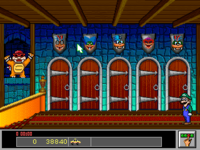
- Athens, Greece (Europe) 1st door
- Madrid, Spain (Europe) 2nd door
- Marrakech, Morocco (Africa) 3rd door
- Mexico City, Mexico (North America) 4th door
- Paris, France (Europe) 5th door
- Third Floor
- Berlin, Germany (Europe) 1st door
- Buenos Aires, Argentina (South America) 2nd door
- Dublin, Ireland (Europe) 3rd door
- Kathmandu, Nepal (Asia) 4th door
- Sydney, Australia (Oceania) 5th door
- Fourth Floor
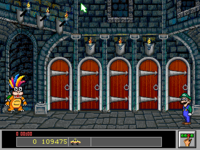
- Amsterdam, Netherlands (Europe) 1st door
- Bombay, India (Asia) 2nd door
- Cairo, Egypt (Africa) 3rd door
- Tokyo, Japan (Asia) 4th door
- Toronto, Canada (North America) 5th door
- Fifth Floor
- Istanbul, Turkey (Europe) 1st door
- Jerusalem, Israel (Asia) 2nd door
- London, United Kingdom (Europe) 3rd door
- New York City, United States (North America) 4th door
- Rio de Janeiro, Brazil (South America) 5th door
SNES version
- First floor
- San Francisco, California, USA (North America)
- Moscow, Russia (Europe)
- Nairobi, Kenya (Africa)
- Beijing, China (Asia)
- Rome, Italy (Europe)
- Second floor
- Paris, France (Europe)
- Mexico City, Mexico (North America)
- Sydney, Australia (Oceania)
- Buenos Aires, Argentina (South America)
- Athens, Greece (Europe)
- Third floor
- London, United Kingdom (Europe)
- Cairo, Egypt (Africa)
- Tokyo, Japan (Asia)
- Rio de Janeiro, Brazil (South America)
- New York City, New York, USA (North America)
NES version
- First room
- New York City, New York (United States)
- Rome, Italy
- Second room
- Sydney, Australia
- San Francisco, California (United States)
- Third room
- Fourth room
- Fifth room
- London, England
- Buenos Aires, Argentina
- Sixth room
- Mexico City, Mexico
- Cairo, Egypt
- Seventh room;
Mistakes and errors
This section is under construction. Therefore, please excuse its informal appearance while it is being worked on. We hope to have it completed as soon as possible. This section is currently under construction by Time Turner (talk).
Although Mario is Missing! is intended to teach its players geographical facts, it contains numerous errors in its teaching material.
- General
- There are many items and objects that are implausibly stolen, such as the entire Sistine Chapel ceiling and the 165-meter[1] Tilted Tower. This is coupled with how all of them can be carried in a small bag by both miscellaneous Koopa Troopas and Luigi.
- Whenever an item is stolen from a landmark, the entire landmark is closed down, even if the item should realistically not affect the location in any way. For example, the theft of a single Striped Prison Shirt causes Alcatraz to shut down.
- In the DOS and Deluxe version, Luigi is required to call phone numbers that are obviously shorter than reality. The numbers within Moscow are only two digits long, for example.
- Several cities that share its name with its surrounding country or state do not have "City" in their name; for example, New York City is simply "New York", Guatemala City is "Guatemala", and so on.
- Diacritics are also not rendered; San José is "San Jose", for example, and Medellín is "Medellin".
- The Deluxe version released in 1993 reuses the map of the DOS version in 1992, meaning that it lists several countries that no longer exist, including Czechoslovakia (which dissolved into the Czech Republic and Slovakia) and Yugoslavia (which dissolved into Bosnia and Herzegovina, Croatia, North Macedonia, Montenegro, Serbia, and Slovenia). It also does not list Eritrea, which split from Ethiopia.
- However, countries such as Croatia, Macedonia, and Eritrea gained independence in 1991.
- All other mistakes between the DOS and Deluxe versions are also identical.
- No cities are listed for Armenia or Brunei.
- The capital of Greenland is spelled "Nuk" and not Nuuk.
- El Salvador's name is given as "San Salvador", which is the name of its capital.
- Colombia's capital, Bogotá is misspelled as "Bogata".
- The capital of Venezuela, Caracas, is misspelled as "Caracus".
- Suriname is spelled "Surinam" (although this is the country's old name, "Suriname" is the preferred spelling [2]).
- French Guiana is rendered with a hyphen, as "French-Guiana".
- The capital of Paraguay, Asunción, is spelled "Asucion".
- The city of Bahía Blanca in Argentina is spelled "Bahai Blanca".
- Iceland's capital, Reykjavik, is spelled "Reykavik".
- The capital of Sweden, Stockholm, is spelled "Stolkolm".
- The second-largest city in Bulgaria, Plovdiv, is spelled "Ploudiv".
- Monte Carlo is listed as a city in Monaco, despite being an administrative region.
- Western Sahara is listed as a country despite the still-disputed nature of its sovereignty.
- The city of Smara in Western Sahara is spelled "Semara".
- Kufra is listed as a city in Libya despite being an oasis; its name is even rendered as "Kufra Oasis".
- N'Djamena is rendered with a space, as "N' Djamena".
- El-Obeid is rendered without a hyphen, as "El Obeid".
- The city of Mombasa in Kenya is spelled "Monbassa".
- Lesotho is rendered as "Sinai Lesotho".
- Saudi Arabia's capital, Riyadh, is spelled "Riyad".
- Muttrah is not only listed as a city in Oman, despite being an administrative district, it is also misspelled as "Matrah".
- The capital of Kuwait, Kuwait City, is rendered as "Al Kuwait".
- The city of Tel Aviv in Israel is rendered as "Tel Aviv-Jaffa".
- The city of Ashgabat was spelled "Ashkhabad" before 1991; "Ashkhabad" is the name used in-game.
- The city of Almaty was renamed from "Alma-Ata" after Kazakhstan gained independence (although "Alma-Ata" is a transliteration of the original Russian name); "Alma-Ata" is also the name used in-game.
- Tajikistan's capital, Dushanbe, is spelled "Dashnabe".
- The capital of Mongolia, Ulaanbaatar, is spelled "Ulaabaatar"
- The capital of North Korea, Pyongyang (alternate spelling P'yŏngyang), is rendered as "P'yong'yang".
- Bhutan's capital, Thimphu, is spelled "Thimpu".
- Myanmar is rendered as "MyAnmar".
- Yangon in Myanmar was renamed from "Rangoon" in 1989[3], but the game still uses "Rangoon".
- The city of Kota Kinabalu in Malaysia is spelled "Kota Kinabatu".
- The largest city in New Zealand, Auckland, is spelled "Auchland".
- The Little America exploration base in Antarctica is listed as a city.
- In the SNES version, there are several buildings whose signs read "ΟΔΑΝΤΟΚΡΕNΑ". This seems to be a misspelling of "ΟΔΟΝΤΟΚΡΕΜΑ", which literally means "toothpaste"; if the signs were supposed to read "dentist", this is spelled "ΟΔΟΝΤΙΑΤΡΟΣ".
- A scientist says that Athens became the capital of Greece in 1834, when it was actually in 1833[4].
- He also says that 3000 years had passed between Athens being founded and becoming Greece's capital. As Athens was founded in 3000 BC[5], close to 4,800 years had actually passed between the two dates.
- A policewoman makes a comment about Zorba being here but having "left for the Acropolis". "Zorba" is presumably a reference to the novel and film Zorba the Greek, in which its titular protagonist does not visit the Acropolis at any point.
- A scientist says that the Caryatids have stood for 2000 years. Considering that they were constructed in 406 BC[6], they have stood for close to 2,400 years (at the time of the game's release).
- The Erechtheion Temple's proper name is just the Erechtheion, without the word "temple" being a part of it.
- Despite what its DOS sprite depicts, the Erechtheion Temple does not have four extremely large Caryatids looming over it.
- The temple's pamphlet says that the Caryatids are 6 feet and 6 inches tall, when they are actually around 7.48 feet (2.28 meters)[7].
- The Brass Plaque is nonexistent in reality; the inscriptions of Hadrian's Arch that are supposedly on the plaque are carved directly onto the monument[8].
- It is stated that the arch served to divide the separate cities of Athens and Hadrianopolis, but no proof of two divided cities has been found (rather, they are separate districts of the same city)[9].
- The pamphlet for the arch says that Hadrian commissioned its construction, but it is unknown who actually built it[10]
- It also says that it was constructed in 131 AD; the exact year is not know, being either 131 or 132[10].
- It also mentions that it looks like the Arc de Triomphe in Paris. Beyond how they are both arches, the structures do not resembles each other, and the Arc de Triomphe was not specifically based on Hadrian's Arch.
- The two images for the Parthenon Column conflict with each other: its SNES sprite depicts a broken bottom-half, while its DOS sprite depicts it intact.
- A boy says that the Parthenon is held up by 46 columns, which is not technically accurate when some of them are broken.
- A reporter says that the columns are 36 feet, when they are really 34 feet[11].
- A policewoman says that the Parthenon is "near" the Acropolis, when it is in fact on the hill.
- Athena is described as being the "goddess" of Athens, when "patron" is the accurate term.
- The pamphlet for the Parthenon says that Athens gets its name from Athena; though it has been disputed whether the city is named after the goddess or vice-versa, it is generally believed that Athena was named after the city[12].
- It also says that the Parthenon was constructed between 447 BC and 438 BC; it was actually between 447/446 BC and 443/442 BC[13].
- It also suggests that the statue of Athena's body was solely made out of ivory, when it was a mix of ivory and gold[14].
- It also says that the statue of Athena's dress weighed 2,205 pounds; it actually weighed 44 talents (3,300 pounds)[14].
- A boy describes Scottish kilts and the Foustanellas as being interchangeable, when there are distinct differences between the two garments[15].
- Foustanellas use over 30 meters (around 33 yards) of fabric in their construction[16], and not 25 yards as stated in-game.
- The evzones featured with the Presidential Palace have bright-orange pompoms on their shoes; although the pompoms are standard, their color is unusual[17].
- A boy states that China is the largest country in Asia, even though Russia has the most territory (without even including its territory in Europe)[18]
- A reporter states that Beijing has been the capital of China for 800 years. However, the timeline does not work out: considering that Beijing was officially made the capital in 1279[19], just above 700 years would have passed by the time of Mario is Missing!'s release. This also ignores the two gaps in which Beijing was not China's capital: from 1368 to 1420, when Nanjing was made the capital during the Ming dynasty,[20] and from 1928 to 1949, after the 1928 Chinese reunification and numerous other events until the formation of the People's Republic of China.
- A police officer claims that they are standing on Chang An Avenue. While this makes sense in the SNES version, where every NPC is restricted to one street, the NPCs in the PC versions move around, and the police officer can therefore tell Luigi this on multiple streets.
- A boy says that the Gate of Heavenly Peace leads to the Emperor's home in the Forbidden City, which is misleading: the Forbidden City itself was the Emperor's home.
- A scientist says that the gate was created in the fourth century, while the Forbidden City's pamphlet says that it was built in 1651. Both of these are incorrect: the gate was built in 1417[21], although it was rebuilt in 1651 after being burned down[22].
- The scientist also says that the reigning emperor, the Yongle Emperor, was the one who built the gate. While he ordered its construction, it was designed by Kuai Xiang in conjunction with other architects[23].
- It is stated on several occasions that only the Emperor could pass through the Gate of Heavenly Peace, when it was actually the Gate of China that had this restriction[21].
- It is stated on multiple occasions that the Great Wall of China is the only man-made object that is visible from space, despite this being completely false; other objects are visible from space[24][25] and the wall itself is not even visible[26][27].
- The pamphlet states that the Great Wall is one of "the world's seven great wonders", which is misleading: the traditional list of the seven Wonders of the World does not include the Great Wall, but it is typically included in lists about the wonders of the medieval world[28][29].
- The pamphlet also says that it took 300,000 men ten years to construct the entire Great Wall. This is incorrect for three reasons: for one, portions of the wall were built across several centuries; secondly, several hundreds of thousands[30], if not millions[31], of people were forced to work on the wall; finally, while 300,000 soldiers were conscripted to build one section of the wall, it took them nine years to do so[32].
- It also states that the wall was "[b]egun in fifth century BC", despite walls being constructed many centuries prior; they were also only joined together after 221 BC[33][better source needed]
- Tian An Men Square is claimed to be the largest public square in the world, despite the existence of other squares like Merdeka Square in Jakarta.
- The dialogue makes it clear that the stolen Monument to the People's Heroes refers to the obelisk, but its image depicts a statue outside of the Mausoleum of Mao Zedong (this statue is also what is shown in Luigi's photo of Tian An Men Square).
- It is stated that the monument is made only out of granite, without referencing how it is also made out of marble[34].
- The pamphlet for the square says that it was expanded in 1949, when it was expanded several times starting from the 1950s, most prominently in 1959 when it was expanded to 99 acres (and not 98)[35]
- The building that is stolen from the Temple of Heaven is called the Hall of Good Harvest, the Good Harvest Hall, and the Great Hall in-game, none of which are actually names for it. It is officially the "Hall of Prayer for Good Harvests"[36].
- One of the questions for returning the hall involves answering what was not used during its construction; though "air conditioning" is a technically valid answer, it is not accepted for the question.
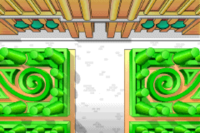
- A policewoman broadly says that the Spanish "dearly love" the Flamenco dance. However, it originated in and mostly thrives in the southern regions of the country[37][38].
- Guernica is stated to be exhibited in the Prado Museum, despite having been moved to the Museo Nacional Centro de Arte Reina Sofía in 1992[39].
- The image of the Prado Museum does not depict the statue of Diego Velázquez[40] at the front of the entrance (although it is visible in the video of the location).
- The pamphlet for the museum touts Guernica as Picasso's most famous painting, which is a claim that is rather difficult to make especially when the painter has numerous other paintings like Les Demoiselles d'Avignon that are also famed[41].
- It is unclear what kind of cape the Matador's Cape actually is: a reporter describes it as "ornate" and a scientist says that the bullfighters wear it (indicating that it is a capote de paseo), while a tourist says that it is waved around during bullfights (indicating that it is a muleta).
- The scientist also says that bullfighting was used to train soldiers, when it was actually a spectacle reserved for aristocracy in the past[42].
- The policewoman suggests that the cape belongs to the Ventas Bullring itself and not an individual bullfighter. This is despite how their entire outfit usually belongs to the bullfighter and how they dress in them outside of the bullring[43].
- The Ventas Bullring's proper name is the Plaza de Toros de Las Ventas, or Las Ventas for short; a literal translation would be the Bullring of Las Ventas.
- The pamphlet for the bullring contends that bullfighting is almost as popular as, if not equal in popularity to, soccer. In reality, soccer is by-and-large the most popular sport throughout the country[44][better source needed].
- The image for the Lion's Tail shows the lion's face.
- A scientist says that the Palacio de las Cortes was built in 1843, when it was actually from 1843 to 1850[45].
- The Palacio de las Cortes is repeatedly called the "Spanish Parliament", despite that not being the name of the building and not all of the Cortes Generales convening there.
- The image for the palace is completely incorrect, as in reality, it does not have any hedges around it.
- The pamphlet describes Francisco Franco as a "stuffy tyrant", which is a gross understatement: he ruled as a militaristic dictator for more than thirty years, and his policies and actions were responsible for 200,000 to 400,000 deaths in his first nine years in power alone (in an event called the White Terror).
- It also says that he died two years before Spain's 1978 constitution was ratified (i.e. in 1976), but he actually died in 1975[46].
- A reporter says that "Montreal is an island in the St. Lawrence River", which is misleading: the player visits the city of Montreal, which is contained within, but distinct from, the Island of Montreal.
- A scientist says that Montreal means "royal mount", which is misleading: "mount" refers to a mountain (its usage is technically correct but unusual).
- The image of the Dome looks nothing like the actual dome of Saint Joseph's Oratory (perhaps coincidentally, it resembles the Montreal Biosphère).
- A reporter suggests that the Dome is only smaller than that of the one on St. Peter's Basilica in Rome; this is very much incorrect[47].
- A policeman mentions 158 light bulbs on the mountain, where there are actually 30 (originally 240 before being changed in 1992)[48].
- A tourist says that the Olympic Stadium seats 70,000 people; its actual max capacity is around 60,000[49].
- A reporter says that the Tilted Tower was built for the 1974 Olympics, and not the 1976 Summer Olympics as in reality.
- While a boy points out GUM's letters in the Cyrillic script, the text misspells Cyrillic as "Cyrlik".
- The largest lake in Russia is said to be the Caspian Sea. However, the Caspian Sea is not fully enclosed within Russia, but merely connected to it, and even then, the largest lake to be connected to Russia is actually the Black Sea. The largest lake to be fully enclosed within Russia is Lake Baikal.
- The height of the central structure of St. Basil's Cathedral is stated to be 107 feet; it is officially 47.5 meters tall, around 156 feet[50].
- The term "Holy Fool" is said to mean "saint" in Russian. This is incorrect: a holy fool refers to anyone who surrenders themselves to God at the expense of themselves and societal norms, even if they are not a saint, and the concept of Foolishness for Christ appears outside of Russia, even within the Bible itself.
- The pamphlet for the cathedral says that it was built in 1555, which is misleading when it was constructed from 1555 to 1560[51].
- It also says that it was built by "Ivan III", while also calling him Ivan the Terrible. While Ivan the Terrible did order its construction, he was "Ivan IV"; Ivan III was his grandfather.
- It also says that he ordered the cathedral built to honor Basil the Blessed. It was actually built to commemorate his recent victory in conquest; Basil's name was only attached to the building in the seventeenth century[52]. While St. Basil does have a mausoleum within the cathedral, it was only constructed in 1588[50].
- Despite what its image shows, Lenin's Tomb is made out of marble and granite and not a metallic chrome.
- The image for the Guard's Hat Pin does not depict a red star behind the hammer and sickle as it should.
- The October Revolution led by Vladimir Lenin is generically called the "Communist revolution" (which is an issue when there exists several communist revolutions).
- It is claimed that the hammer and sickle was "the" symbol for Communist Russia. Although the hammer and sickle is widely associated with communism, there exist other symbols with a connection to Communist Russia, such as the red star, as depicted on the Flag of the Soviet Union.
- The names "Bolshoi Ballet" and "Bolshoi Theater" are used interchangeably (for example, it is stated that the Bolshoi Ballet has been closed for visitors). However, the Bolshoi Ballet is a dance troupe, whereas the Bolshoi Theater is an actual building.
- It is claimed that the Bolshoi Theater "sells out every show." This is despite a period where it struggled to gather an audience[53], which is to say nothing of canceled shows in the past[54].
- Its pamphlet attributes the introduction of realism to ballet with one of the Bolshoi Ballet's directors, Alexander Alexeyevich Gorsky; realism within ballet can actually be traced to the 1830s[55]
- It also claims that Gorsky served as the director until 1942, despite him dying in 1924[53].
- It also claims that the theater was constructed in 1856; it was actually in 1780, with restorations taking place until 1856 after a fire in 1853[56].
- The image for the Moscow Metro M depicts its neon as an unconnected line, although the sign is actually a connected outline of the M[57].
- A scientist says that the Moscow Metro was built by Joseph Stalin. Although he gave the project its final approval, it was not his idea, and he had no hand in the project in any way otherwise[58]
- The metro's pamphlet claims that the Moscow Metro has "not much competition" when it comes to underground rapid transit, which is odd when there existed over 80 metro systems at the time of the game's release[59].
- A tourist says that the Emperor's Bell weighs 210 tons. Officially, it is about 202 tons[60].
- A reporter claims that Ivan III had the bell placed in the Ivan the Great Bell Tower. This tower has 22 bells, none of which are the Emperor's Bell; it has never once been suspended or rung[61]
- A policewoman says that the bell has been in the Kremlin since the 17th century. It has actually been there since it was constructed in 1735 (i.e. the 18th century)[61]; it was also moved to its current location in 1836[62]
- A boy claims that the Tsar Cannon is the largest one ever created. Though it is the largest bombard, there exists both the Little David and the Mallet's Mortar[63]
- A scientist says that the cannonballs for the Tsar Cannon were cast alongside it in 1586; in reality, they were cast in the 19th century[64]
- The pamphlet for the Kremlin states that the cannon was cast by "Andrey Shchokhov", whose name is actually Andrey Chokhov.
- Many of the buildings in Nairobi are old and dilapidated, with some even being held up with sticks and straw roofs; this is a far cry from the contemporary city in reality.
- A tourist said that he had to fight off lions and elephants when traveling from Mombasa to Nairobi, which is odd given that there is a highway that directly connects the two cities.
- A scientist comments that female Asian elephants cannot grow tusks, which is incorrect. Some of them have smaller tusks, called "tushes", that are notably more brittle than males' tusks, but are still present. The scientist also implies that male Asian elephants always grow tusks, which is also incorrect.[65]
- The pamphlet for the Nairobi National Park describes the area as "undisturbed", which is incorrect given the proximity of human civilization and how it interferes with the area[66].
- The Maasai Headdress, in both its NES and SNES sprites, look nothing like the enkuraru headdresses worn by actual Maasai warriors[67][68].
- The pamphlet for the Maasai village says that Africa has "more than 70 tribes", which is a gross understatement: estimates often place more than 3,000 tribes in Africa[69][70].
- The pamphlet also says that new warriors are initiated as soon as they turn fifteen, but this process can begin anywhere from the ages of fourteen to eighteen[71]
- The National Museum of Kenya's actual name is the Nairobi National Museum[72].
- The Human Skull was discovered by Bernard Ngeneo, a member of Richard Leakey's expedition team, and not Leakey himself[73].
- Also, unlike what the game claims, the skull depicts a member of the Homo rudolfensis species and not Homo habilis (although initial claims thought the skull to be Homo habilis, it was first classified as a new species in 1986[74]).
- The revolving restaurant at the top of the Kenyatta International Conference Center shut down in the 1980's,[75] and yet it is still depicted as being operational in-game.
- A scientist says that construction on the center finished in 1970, when it was actually in 1973[76].
- Also, the building is 28 stories tall, and not 27 as the pamphlet says[76].
- The center is also describes as being a "United Nations headquarters". Although the fourth United Nations Conference on Trade and Development did take place at the center, this was only for the purposes of the assembly; the building was never used as a headquarters[77][78].
- The pamphlet for the center describes Jomo Kenyatta solely as a "freedom fighter". For starters, although he rallied for Kenya to be freed from British rule, he did so through non-violent means and actively opposed others' brutal methods[79] (labelling him as a "freedom fighter" due to his desire for an independent Kenya is a misuse of the term, anyways). Beyond that, he is best known as the first Prime Minister and President of Kenya, and not as a "freedom fighter".
- King Kong is stolen from the Empire State Building and must be returned to its supposed rightful place, despite King Kong being entirely fictional.
- A boy mentions that France is the biggest country in Europe after the Soviet Union has broken up, despite that Russia's European portion and Ukraine's land area is larger than France.[80]
- A tourist misspells "aéroport" as "airport" in L'Airport d'Orly.
- A business woman mentions obtaining French fries though their origin as a French food has been disputed, with sources citing origins in possibly Belgium or Spain.[81]
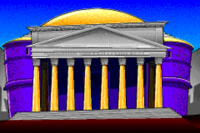
- A tourist uses the name "Latin Manhattan" for Rome. This has never been a nickname for the city; in fact, it is an alcoholic drink[82]. However, the nickname has been associated with Buenos Aires[83].
- The Colosseum's pamphlet lists its circumference as 573 yards, and not 544 meters (about 594 yards) as in reality[84].
- The Michelangelo's Paintbrush item is touted as if it was his sole painting tool; there is no evidence that Michelangelo used a single paintbrush for the entirety of the Sistine Chapel, nor is there a paintbrush that is particularly famous for being used by him.
- A scientist says that "Sistine" means six in Latin. Six in Latin is "sex" or "sextus"; "Sistine" refers to any of the Sixtus popes, although "Sixtus" is derived from "sextus"[85].
- The Sistine Chapel's pamphlet describes Michelangelo painting the Sistine Chapel ceiling's 10,000 square feet. He actually painted around 534 square meters (about 5,747 square feet)[86].
- It also describes him as having painted while lying down, which is a common misconception. He actually painted while standing up.[87]
- The Trevi Fountain's pamphlet says that anyone who throws a coin over their shoulder and into the fountain is guaranteed to return to Rome. Although technically correct, this is missing details, as the myth specifies that a person must throw a coin with their right hand over their left shoulder[88].
- The Trevi is also said to be the oldest fountain in Rome, which is incorrect due to the Fountain in Piazza Santa Maria in Trastevere.
- The Pantheon is stated to have eight columns when it actually has sixteen[89].
- Its pamphlet also says that it was made out of brick and marble, completely ignoring how the Pantheon was largely constructed with concrete[90].
- The pamphlet for the Spanish Steps says that it was paid with "French" money, this is incorrect. The money was left by French diplomat Étienne Gueffier in his will, but it was in scudi, a depreciated Italian coin[91].
- It also says that the Spanish embassy that lent its name to the stairs was an embassy for "the Vatican"; it is an embassy to the Holy See, which is distinct from Vatican City[92].
- Also, the Spanish Steps only have 135 steps[93], and not 328 as the game claims.
- A scientist says that "no one" was interested in San Francisco until the California Gold Rush in 1848, which is a rather flippant statement. Although the gold rush brought droves of new people to the settlement, it still had a sizable population; it was the initially steady influx of immigrants that allowed people to explore the surrounding territory in the years leading up to the gold rush.[94].
- The Fog Horn is touted as if it is the only one along the Golden Gate Bridge, despite there being multiple fog horns[95].
- A boy states that the Bridge is 260 feet above the San Francisco Bay, although it is actually 220 feet above water from bridge itself and 500 feet above land from the top of the tower[96]
- It is stated that the Bridge was built in 1937, which is misleading when construction started in 1933 and finished in 1937[97].
- The pamphlet for the bridge says that fog covers it on "most days"; fog usually rolls over during the summer[98]
- The Coit Tower was purportedly built in 1934; it was actually in 1933[99].
- The Tower's pamphlet says that its namesake is "Lillian Hitchcock Coit"; her name is actually Lillie Hitchcock Coit.
- It also claims that Lillie donated $125,000 specifically to build the tower. Firstly, she donated $118,000 (although this expanded to $125,000 due to additional city funds), and she also donated the money to city for the general purpose of beautification, and not solely for the tower[100].
- The game is insistent that the prisoners in Alcatraz wore striped prison uniforms, despite this never being the case[101][102].
- The pamphlet for Alcatraz says that it is named after the Spanish word for "pelican". This is misleading, as the word has since become archaic (the contemporary word for "pelican" is "pelicano").
- Gripmen[103] are consistently called "gripsmen".
- The pamphlet for the Cable Car says that they weigh six tons, when they actually weight 15,500 pounds (about 7.75 tons)[104].
- It also says that they move consistently at 9 miles per hour; it's actually 9.5 miles per hour[105].
- Despite what the DOS image for the Transamerica Pyramid depicts, it is not slanted from the ground at a 45° angle.
- The Transamerica Pyramid is on Montgomery Street, and not Columbus Avenue as its pamphlet claims.
- Its pamphlet only mentions that it is on a concrete base, disregarding the steel that was also used[106].
- A woman explains that "I always thought Australia's capital was spelled like "Sid's-Knee"", referring to Sydney, when in reality it is Canberra that is Australia's capital, a fact which is stated by another NPC in the game.
Gallery
- For this subject's image gallery, see Gallery:Mario is Missing!
- Ss mim-pc t.png
PC title screen
- Ss mim-snes title.png
SNES title screen
- Ss mim-nes t.png
NES title screen
Mario meeting Luigi in the PC version (scene by Dan Guerra[107])
Media
- For a complete list of media for this subject, see List of Mario is Missing! media.
Quotes
- Main article: List of Mario is Missing! quotes
Pre-release and unused content
It has been requested that this article be rewritten and expanded to include more information. Reason: include information about lots of unused sprites from NES version
Unused data
Dialogue intended for the ending of the game is in the CD-ROM Deluxe edition of the game: Game ending reconstructed with voices.
It also appears that Lemmy and Morton were going to appear in game, as their unused dialogue was found in the Deluxe version's data (they are the only Koopalings who do not appear in at least one version of the game)[108]. In the final game, Lemmy is mentioned as having run off to play in the snow while Morton is said to watch the others.[citation needed] Furthermore, the CD-ROM release of the game features Lemmy on the cover despite him not appearing in the game.[109]
The Deluxe edition's files also contain live-action footage featuring landmarks of several cities that are not visited in-game. These include:
- Wat Phra Kaew, the Chao Phraya River, and Wat Pho in Bangkok, Thailand;
- Taft Avenue, the Intramuros, Rizal Park, and the Malacañang Palace in Manila, Philippines;
- Hotel Gellért, the Széchenyi Chain Bridge, the Fisherman's Bastion, and the Hero's Square in Budapest, Hungary;
- Mount Royal, the Olympic Stadium, Saint Joseph's Oratory, and the Notre-Dame Basilica in Montreal, Canada (although the city is featured in the game's NES release);
- Victoria Peak, the Tiger Balm Garden, the The Excelsior, and the HSBC Building in Hong Kong, China;
- The Sunda Kelapa port and the National Monument in Jakarta, Indonesia;
- The White House, the Washington Monument, the Lincoln Memorial, and the United States Supreme Court Building in Washington, D.C., United States of America;
- The Government Palace and the Plaza Mayor in Lima, Peru;
- Al-Kāẓimiyyah and the Tigris river in Baghdad, Iraq;
- Suomenlinna, Helsinki Central Station, Temppeliaukio Church, and the Sibelius Monument in Helsinki, Finland;
There are exactly ten cities that go unused; considering the unused dialogue for Lemmy and Morton and how every other Koopaling guards five cities of their own, it is likely that they were meant to guard the unused cities.
There are also unused voice clips that reference locations that are not in-game, including those that do not even have footage. Beyond the previously mentioned landmarks, these include: the Lacqueur Pavilion in Bangkok; the Bogor Botanical Gardens and the National Museum of Indonesia in Jakarta; the Cathedral of Lima in Lima; and the Archway of Ctesiphon near Baghdad. The Notre-Dame Basilica in Montreal is the only landmark to have a video clip and not a corresponding audio clip. Also, the White House and the Supreme Court are the only ones to have unique messages: "We are attempting to achieve world peace and are unable to take your call," and "We are hearing an important case and are unable to take your call," respectively.
Reception
Sales
In an August 1993 press release, Software Toolworks claimed that sales of the console versions of Mario is Missing! exceeded $7,000,000 for the fiscal quarter and that the game boosted the company's revenue during a slow quarter[110]. One employee also claims that the game sold over one million units.[111]
Legacy
Luigi's sprite in the PC version started the Internet meme "Weegee", as well as Mario being "Malleo" and Yoshi being called "Yushee".
References to other games
- Super Mario Bros. - The Koopa Troopas look similar to their Super Mario Bros. artwork in the MS-DOS version.
- Super Mario World - The Mario, Luigi and Yoshi sprites in the NES and SNES versions were taken from this game. Bowser's sprite in the NES version appears to use an edited version of Morton, Ludwig, and Roy's body from this game, along with an edited version of Lemmy's head. As such, he is uncharacteristically short in this game. When retracted into his shell, it uses the normal Koopa Troopa shell sprite from this game, except with all original detail removed and spikes drawn on. Finally, after defeat, he is knocked out of his shell and appears as a Koopa without a Shell, specifically from a Koopa Troopa.
Staff
- Main article: List of Mario is Missing! staff
Names in other languages
| Language | Name | Meaning | Notes |
|---|---|---|---|
| German | Mario wird vermißt![?] | Mario is missing! |
Trivia
- According to the MS-DOS release, Mario has a fear of the dark, which he is increasingly worried that Bowser will exploit in torture. This is not seen or referenced in other games, except potentially Hotel Mario when he stutters before entering the cave hotel without a flashlight.
- Mario's voice is inconsistent in the the CD-ROM Deluxe edition. Sometimes he has an Italian accent, sometimes he has a New York accent with a slight hint of Italian. The game's data includes all of his lines in both accents, so it's likely that the developers accidentally assigned some from both. [112]
- Luigi, however, has a consistent New York accent.
- Although some Mario media supply voice acting for the Koopalings, the CD-ROM Deluxe edition is the first game to have the Koopalings voiced, as well as the only game to actually supply them with dialogue until the release of Mario & Luigi: Paper Jam. Later games starting with New Super Mario Bros. Wii have the Koopalings voiced, although it is limited to roars and grunts.
- The USA and Canada are the only countries that are visited twice at different cities in all versions of the game (New York and San Francisco in USA, Toronto and Montreal in Canada).
References
- ^ "The Montréal Tower." Parcolympique.qc.ca, parcolympique.qc.ca/en/what-to-do/the-montreal-tower/. Retrieved February 2, 2018.
- ^ Bryson, Bill. "S." Bryson's Dictionary of Troublesome Words: A Writer's Guide to Getting It Right, Doubleday Canada, 2013. Google Books, books.google.ca/books?id=I-nqQ2MRylMC. Retrieved January 21, 2018.
- ^ "Myanmar Profile - Timeline." BBC News, BBC, 11 Jan. 2018, www.bbc.com/news/world-asia-pacific-12992883. Retrieved January 21, 2018.
- ^ Hall, Thomas. "Athens." Planning Europe's Capital Cities: Aspects of Nineteenth-Century Urban Development, Routledge, 2003, p. 114. Google Books, books.google.ca/books?id=7wORAgAAQBAJ. Retrieved February 8, 2018.
- ^ "Athens History." Athensguide.org, Athens Greece Guide, 2007, www.athensguide.org/athens-history.html.
- ^ Langmea, Donald, and Christine Garnaut. "Erechtheion." Encyclopedia of Architectural and Engineering Feats, illustrated ed., ABC-CLIO, 2001, pp. 110–111. Google Books, books.google.ca/books?id=T5J6GKvGbmMC. Retrieved February 8, 2018.
- ^ "Caryatid." British Museum, Trustees of the British Museum, 2017, www.britishmuseum.org/research/collection_online/collection_object_details.aspx?objectId=459389&partId=1. Retrieved February 8, 2018.
- ^ Nefasdicere. "J. Matthew Harrington, Personal Digital Image." Wikimedia Commons, Wikimedia Foundation, 4 Mar. 2007, commons.wikimedia.org/wiki/File:Arch-of-Hadrian-5.jpg. Retrieved February 7, 2018.
- ^ Taliaferro, Mary. "Athens, Smyrna, and Italica." Hadrian and the Cities of the Roman Empire, Boatwright, illustrated, reprint, revised ed., Princeton University Press, 2000, p. 147. Google Books, books.google.ca/books?id=YmKmSTzToCMC. Retrieved February 7, 2018.
- ^ a b Camp, John M. "Roman Athens." The Archaeology of Athens, illustrated, reprint ed., Yale University Press, 2001, pp. 201–202. Google Books, books.google.ca/books?id=xoLMeXZhdPkC. Retrieved February 8, 2018.
- ^ "Athens, Parthenon (Building)." Perseus.tufts.edu, Tufts University, www.perseus.tufts.edu/hopper/artifact?name=Athens%2C%2BParthenon&object=Building. Retrieved February 7, 2018.
- ^ Burkert, Walter. "Athena." Greek Religion, reprint ed., Harvard University Press, 1985, p. 139. Google Books, books.google.ca/books?id=sxurBtx6shoC. Retrieved February 8, 2018.
- ^ Beard, Mary. "'The Template They Call the Parthenon'." The Parthenon, revised ed., Harvard University Press, 2010, p. 42. Google Books, books.google.ca/books?id=q6MlnesZaRoC. Retrieved February 8, 2018.
- ^ a b Eddy, Samuel. "The Gold in the Athena Parthenos." American Journal of Archaeology, vol. 81, no. 1, 1977, pp. 107–111. JSTOR, www.jstor.org/stable/503656, doi:10.2307/503656. Retrieved February 8, 2018.
- ^ Dioghaltas. "The fustanella. What is it? And why it isn't a Kilt." Nuairathigairduinethigairuile, Wordpress, 9 Jan. 2017, nuairathigairduinethigairuile.wordpress.com/2017/01/09/the-fustanella-what-is-it-and-why-it-isnt-a-kilt/. Retrieved February 8, 2018.
- ^ "Why Athens". "Evzones Uniform, the Costume of an Elite Greek Soldier." Why Athens, 13 Sept. 2017, whyathens.com/evzones-uniform-greek-soldier/. Retrieved February 7, 2018.
- ^ Adare, Sierra. "Skirts for all." Greece: The Culture, illustrated, revised ed., Crabtree Publishing Company, 2007, p. 20. Google Books, books.google.ca/books?id=r3YSQx7Lt9wC.
- ^ Pariona, Amber. "Which Are the 10 Largest Asian Countries By Area?" WorldAtlas, 3 Nov. 2017, www.worldatlas.com/articles/which-are-the-10-largest-asian-countries-by-area.html.
- ^ Wang, Yi. "Dadu in the Yuan Dynasty." A Century of Change: Beijing's Urban Structure in the 20th Century, illustrated ed., Springer International Publishing, 2016, p. 14. Google Books, books.google.ca/books?id=RRq1DAAAQBAJ. Retrieved January 26, 2018.
- ^ Fang, Jun. China's Second Capital – Nanjing under the Ming, 1368-1644. Routledge, 2014. Google Books, books.google.ca/books?id=f1uhAwAAQBAJ. Retrieved January 26, 2018.
- ^ a b "People's Daily Online". "The History of Tiananmen Gate." eBeijing, 26 Nov. 2010, www.ebeijing.gov.cn/BeijingInformation/BeijingsHistory/t1141051.htm. Retrieved January 26, 2018.
- ^ "Tian'anmen -- the Gate of Heavenly Peace." China.org.cn, China Internet Information Center, www.china.org.cn/english/features/beijing/30801.htm. Retrieved January 26, 2018.
- ^ "Designer of Tiananmen." Beijing Attractions, 2010, www.beijingattractions.org/Beijing-History/Designer-of-Tiananmen.html. Retrieved January 26, 2018.
- ^ Miles, Kathy A. "Viewing Earth: How Much Can Be Seen from Space?" Starryskies.com (Archive.org), 2004, web.archive.org/web/20060212052143/http://starryskies.com/articles/2003/10/earth.visible.html. Retrieved January 24, 2018.
- ^ Sweeney, Chris. "The World's 18 Strangest Gardens." Popular Mechanics, 11 Aug. 2010, www.popularmechanics.com/home/lawn-garden/how-to/g348/worlds-18-strangest-gardens/#slide-5.
- ^ Adams, Cecil. "Is the Great Wall of China the Only Manmade Object You Can See from Space?" The Straight Dope, 31 Jan. 1986, www.straightdope.com/columns/read/417/is-the-great-wall-of-china-the-only-manmade-object-you-can-see-from-space/. Retrieved January 24, 2018.
- ^ Mikkelson, David. "Can You See the Great Wall of China from the Moon?" Snopes.com, 20 July 2014, www.snopes.com/science/greatwall.asp. Retrieved January 24, 2018.
- ^ "Seven Wonders of the Medieval World." Unmuseum.org, www.unmuseum.org/7wonders/medieval_wonders.htm.
- ^ Oberheu, Caroline. "The 7 Wonders of the Medieval World." WorldAtlas, 6 Sept. 2017, www.worldatlas.com/articles/the-7-wonders-of-the-medieval-world.html.
- ^ Slavicek, Louise Chipley. "The Human Cost of Building the First Great Wall." The Great Wall of China, Infobase Publishing, 2009, pp. 33–35. Google Books, books.google.ca/books?id=EwFYg_twIgYC. Retrieved January 26, 2018.
- ^ Evans, Thammy. "Myths." Great Wall of China: Beijing & Northern China, illustrated ed., Bradt Travel Guides, 2006, p. 11. Google Books, books.google.ca/books?id=C5w9M8n9_a8C. Retrieved January 26, 2018.
- ^ "Labor Force of Great Wall." Travelchinaguide.com, www.travelchinaguide.com/china_great_wall/construction/labor_force.htm. Retrieved January 27, 2018.
- ^ "Qin Dynasty Great Wall." travelchinaguide.com, www.travelchinaguide.com/china_great_wall/history/qin/. Retrieved January 27, 2018.
- ^ "Monument to the People's Heroes." China.org.cn, China Internet Information Center, www.china.org.cn/english/features/beijing/30800.htm. Retrieved January 27, 2018.
- ^ Li, Lillian M., et al. "Mao's Beijing and Socialist Transformation." Beijing: from Imperial Capital to Olympic City, Palgrave Macmillan, 2008, pp. 177–178. Amazon, www.amazon.ca/Beijing-Imperial-Capital-Olympic-City/dp/0230605273. Retrieved January 27, 2018.
- ^ "The Hall of Prayer for Good Harvests.' en.tiantanpark.com, en.tiantanpark.com/showdetail.aspx?IID=48&Sortid=15. Retrieved January 26, 2018.
- ^ "Flamenco History." red2000.com, All About Spain, www.red2000.com/spain/flamenco/history.html. Retrieved February 11, 2018.
- ^ Ruiz, Ana. "Flamenco." Vibrant Andalusia: The Spice of Life in Southern Spain, Algora Publishing, 2007, pp. 71–90. Google Books, books.google.ca/books?id=D0uZimSR8EUC. Retrieved February 11, 2018.
- ^ "History." Museodelprado.es, (Wayback Archive), 15 Sept. 2009, web.archive.org/web/20120629154010/http://www.museodelprado.es/en/la-institucion/the-extension/el-cason-del-buen-retiro/historia/. Retrieved February 10, 2018.
- ^ Carro, Javier. "Diego Velázquez." Wikimedia Commons, Wikimedia Foundation, 9 Nov. 2004, commons.wikimedia.org/wiki/File:Vel%C3%A1zquez_en_El_Prado.JPG. Retrieved February 12, 2018.
- ^ Halle, Howard. "The 10 Best Picasso Paintings and Sculptures, Ranked." Time Out New York, Time Out Group Plc, 12 Feb. 2016, www.timeout.com/newyork/art/best-picasso-paintings-and-sculptures-ranked. Retrieved February 12, 2018.
- ^ De Larra, Mariano José. "Corridas De Toros." Fundación Biblioteca Virtual Miguel De Cervantes, www.cervantesvirtual.com/obra-visor/corridas-de-toros--0/html/ff76f7ea-82b1-11df-acc7-002185ce6064_1.html. Retrieved February 11, 2018.
- ^ Kennedy, A.L. "Acts of Faith." On Bullfighting, Random House, 2010, pp. 100–101. Google Books, books.google.ca/books?id=4RIqWCxmv6cC. Retrieved February 12, 2018.
- ^ "Football in Spain." Just Landed, 28 Oct. 2014, www.justlanded.com/english/Spain/Articles/Culture/Football-in-Spain. Retrieved February 12, 2018.
- ^ "Documentos Elecciones 31 De Agosto De 1850." Congreso.es (Spanish), www.congreso.es/portal/page/portal/Congreso/Congreso/Hist_Normas/PapHist/Regen/DecMod/elec18500831/docs31081850. Retrieved February 11, 2018.
- ^ The Local. "On This Day in 1975: Spain's Dictator General Francisco Franco Died." thelocal.es, The Local, 20 Nov. 2015, www.thelocal.es/20151120/on-this-day-spanish-dictator-francisco-franco-dies. Retrieved February 12, 2018.
- ^ Wikipedia contributors. "List of largest domes." Wikipedia, The Free Encyclopedia. 4 Jan. 2018. en.wikipedia.org/wiki/List_of_largest_domes. Retrieved February 5, 2018.
- ^ Wilton, Katherine. "The Cross on Mount Royal: a Storied History." Montreal Gazette, 6 Jan. 2015, montrealgazette.com/news/local-news/the-cross-on-mount-royal-a-storied-history. Retrieved February 4, 2018.
- ^ "The Stadium." Parc Olympique, parcolympique.qc.ca/en/what-to-do/olympic-stadium/. Retrieved February 4, 2018.
- ^ a b "Церковь Покрова Пресвятой Богоматери." Панорама 360, www.shm.ru/pano360/ (Russian). Retrieved January 28, 2018.
- ^ Berton, Kathleen. "St. Basil's." Moscow: An Architectural History, St. Martin's Press, 1977, pp. 40–43. Archive.org, archive.org/details/moscowarchitectu00murr. Retrieved January 30, 2018.
- ^ Shvidkovsky, Dmitry. "St Basil's Cathedral and the Architectural Tastes of Ivan the Terrible." Russian Architecture and the West, translated by Antony Wood, illustrated ed., Yale University Press, 2007, p. 126. Google Books, books.google.ca/books?id=LQy9TJ2yOQEC.
- ^ a b Michelman, Fran. "Alexander Gorsky." Abt.org, 2007, www.abt.org/education/archive/choreographers/gorsky_a.html.
- ^ "Bolshoi Theatre Postpones Rudolf Nureyev Ballet." BBC News, BBC, 11 July 2017, www.bbc.com/news/av/entertainment-arts-40570212/bolshoi-theatre-postpones-rudolf-nureyev-ballet. Retrieved January 30, 2018.
- ^ Kisselgoff, Anna. "HOW REALISM IN MIME AND ROMANTIC BALLET BEGAN." The New York Times, 4 May 1985, www.nytimes.com/1985/05/05/movies/dance-how-realism-in-mime-and-romantic-ballet-began.html?pagewanted=all. Retrieved January 30, 2018.
- ^ "History." Bolshoi.ru, 2015, www.bolshoi.ru/en/about/hist/history/. Retrieved January 30, 2018.
- ^ Shcherbakov, Mikhail (Vokabre). "Marksistskaya Station Entry, Moscow Metro Sign (Вход На Станцию Марксистская, Знак Московского Метро) (5062480611).Jpg." Wikimedia Commons, Wikimedia Foundation, https://commons.wikimedia.org/wiki/File:Marksistskaya_station_entry,_Moscow_Metro_sign_(Вход_на_станцию_Марксистская,_знак_Московского_Метро)_(5062480611).jpg. Retrieved January 30, 2018.
- ^ "Building the Moscow Metro, or the brief history of the underground city." Moscow City Web Site, Mos.ru, 13 Sept. 2017, www.mos.ru/en/news/item/28604073/. Retrieved January 30, 2018.
- ^ Wikipedia contributors. "List of metro systems." Wikipedia, The Free Encyclopedia. 31 Jan. 2018. en.wikipedia.org/wiki/List_of_metro_systems*List. Retrieved January 31, 2018.
- ^ "Tsar Bell." Kreml.ru, www.kreml.ru/?cmd=00300100000000000110000000000000000&cmdex=4090007FCE51C00000000. Retrieved January 28, 2018.
- ^ a b Timofeychev, Alexey. "The Tsar Bell: How Russian Craftsmen Made the Impossible." Russia Beyond, 24 Oct. 2017, www.rbth.com/history/326491-tsar-bell-russian-craftsmen. Retrieved January 31, 2018.
- ^ Richardson, Dan, and Jonathon Reynolds. "Red Square and the Kremlin." The Rough Guide to Moscow, Rough Guides, 2009, p. 85. Google Books, books.google.ca/books?id=63i0BgAAQBAJ. Retrieved January 31, 2018.
- ^ Burbach, David. "The 10 Biggest Guns in History Ranked by Caliber." Thrillist, 6 Feb. 2015, www.thrillist.com/gear/largest-caliber-guns-in-history-big-cannons-and-projectiles. Retrieved January 31, 2018.
- ^ Chernov, Vladimir. "First Day." Moscow: a Short Guide, edited by I. A. Romashkevich. translated by J. C. Butler, Moscow Progress Publishers, 1979, p. 56. Archive.org, archive.org/details/moscowshortguide00cher. Retrieved January 28, 2018.
- ^ "Asian elephant." Smithsonian's National Zoo, The Smithsonian, 15 Aug. 2017, nationalzoo.si.edu/animals/asian-elephant. Retrieved January 24, 2018.
- ^ Morell, Virginia. "Surrounded! - Civilization Is Encroaching on Nairobi National Park in Kenya - Nairobi's Wild Side." International Wildlife, vol. 26, no. 4, 1996. Findarticles.com, archive.org, web.archive.org/web/20050115230346/http://findarticles.com/p/articles/mi_m1170/is_n4_v26/ai_18388413. Retrieved January 24, 2018.
- ^ "Maasai Peoples - Enkuraru Headdress." Spencer Museum of Art, University of Kansas, 2016, collection.spencerart.ku.edu/eMuseumPlus?service=ExternalInterface&module=collection&objectId=35893&viewType=detailView. Retrieved January 23, 2018.
- ^ "Maasai Warrior with Red Ochre Face Paint, Kenya." Carol Beckwith & Angela Fisher, 2012, carolbeckwith-angelafisher.com/collections/painted-bodies/maasai-warrior-with-red-ochre-face-paint-kenya/. Retrieved January 24, 2018.
- ^ "African Tribe List." interesting-africa-facts.com, interesting-africa-facts.com/Africa-People/African-Tribe-List.html. Retrieved January 24, 2018.
- ^ "People of Africa." africanholocaust.net, www.africanholocaust.net/peopleofafrica.htm. Retrieved January 24, 2018.
- ^ Temps, Dietmar. "Morani - The Warriorhood Tradition of the Kenyan Tribes." dietmartemps.com, dietmartemps.com/travel-blog/morani-the-warriorhood-tradition-of-the-kenyan-tribes_669/. Retrieved January 24, 2018.
- ^ "Nairobi National Museum." National Museums of Kenya, www.museums.or.ke/introduction/. Retrieved January 22, 2018.
- ^ Leakey, R. E. F. "Evidence for an Advanced Plio-Pleistocene Hominid from East Rudolf, Kenya." Nature, vol. 242, no. 5398, 13 Apr. 1973, pp. 447–450., doi:10.1038/242447a0. Retrieved January 24, 2018.
- ^ Smithsonian's National Museum of Natural History. "Homo rudolfensis." The Smithsonian Institution's Human Origins Program, The Smithsonian, 1 Mar. 2010, humanorigins.si.edu/evidence/human-fossils/species/homo-rudolfensis.
- ^ Kamau, Macharia. "Historical KICC Hotel Back to Life." standardmedia.co.ke, The Standard, 19 Feb. 2012, 00:00, www.standardmedia.co.ke/article/2000052405/historical-kicc-hotel-back-to-life. Retrieved on January 23, 2018.
- ^ a b "administrator". “The Kenyatta International Conference Centre.” Buildesign.co.ke, 7 June 2013, buildesign.co.ke/the-kenyatta-international-conference-centre/. Retrieved January 24, 2018.
- ^ Mochorwa, Silvia. "Kenya's Mice Tourism Goes a Notch Higher." kicc.co.ke, 8 Jan. 2016, kicc.co.ke/media/newsDetails/35. Retrieved January 23, 2018.
- ^ United Nations Conference on Trade and Development, Proceedings of the United Nations Conference on Trade and Development FOURTH SESSION Nairobi (5-31 May 1976), unctad.org/en/Docs/td218vol1_en.pdf. Retrieved on January 23, 2018.
- ^ "Kenyatta, Jomo 1891(?)–1978." Contemporary Black Biography. Encyclopedia.com. 21 Jan. 2018 www.encyclopedia.com/people/history/african-history-biographies/jomo-kenyatta. Retrieved January 23, 2018.
- ^ The Largest Countries in Europe World Atlas. Retrieved April 10, 2019.
- ^ Rupp, Rebecca (January 8, 2015) Are French Fries Truly French? National Geographic. Retrieved April 10,2019.
- ^ Dietz, Frieda Meredith. "Latin Manhattan." Let's Talk Turkey: Adventures and Recipes of the White Turkey Inn, Dietz Press, 1948, p. 79. Google Books, books.google.ca/books?id=2zVKAAAAMAAJ. Retrieved January 21, 2018.
- ^ Lloyd, Harvey. "The Appeal of Buenos Aires." Voyages: The Romance of Cruising, Dorling Kindersley, 1999, p. 115. Archive.org, archive.org/details/voyagesromanceof00harv. Retrieved January 21, 2018.
- ^ Ruhl, Marcus. "Ancient Roman Colosseum in Rome." Ancient Roman Colosseum: History, Architecture, Purpose, 2013, www.romanlife-romeitaly.com/ancient-roman-colosseum.html. Retrieved January 21, 2018.
- ^ Harper, Douglas. "Sistine (Adj.)." Online Etymology Dictionary, www.etymonline.com/word/sistine. Retrieved January 21, 2018.
- ^ Bambach, Carmen C. "A New Artistic Vision." Michelangelo: Divine Draftsman and Designer, Metropolitan Museum of Art, 2017, p. 83. Google Books, books.google.ca/books?id=3zQ7DwAAQBAJ. Retrieved January 21, 2018.
- ^ "Michelangelo Didn't Lie Down on the Job." The New York Times, 22 Apr. 1989, www.nytimes.com/1989/04/23/opinion/l-michelangelo-didn-t-lie-down-on-the-job-008889.html. Retrieved January 21, 2018.
- ^ "Coins into the Trevi Fountain." WelcomeToRome.net, www.welcometorome.net/en/about-rome/things-not-to-miss/coins-into-the-trevi-fountain. Retrieved January 21, 2018.
- ^ "Interesting Facts About Rome's Pantheon." Rolling Rome, romeonsegway.com/10-facts-about-the-pantheon/. Retrieved January 21, 2018.
- ^ Moore, David. "The Pantheon." Romanconcrete.com, 1995, www.romanconcrete.com/docs/chapt01/chapt01.htm.
- ^ Elling, Christian. Rome: The Biography of Her Architecture from Bernini to Thorvaldsen, illustrated ed., Westview Press, 1975, p. 328. Google Books, books.google.ca/books?id=rOxPAAAAMAAJ. Retrieved January 21, 2018.
- ^ Chepkemoi, Joyce. "What Is the Difference Between the Vatican City and the Holy See?" WorldAtlas, 21 June 2017, www.worldatlas.com/articles/what-is-the-difference-between-vatican-city-and-the-holy-see.html. Retrieved January 21, 2018.
- ^ Edwards, Catherine. "Eight Things You Should Know about Rome's Spanish Steps." The Local, 23 Sept. 2016, www.thelocal.it/20160923/eight-things-you-should-know-about-romes-spanish-steps. Retrieved January 21, 2018.
- ^ Richards, Rand. "The Gold Rush (1848-1849)." Historic San Francisco: A Concise History and Guide, illustrated ed., Heritage House Publishers, 2007, pp. 57–62. Google Books, books.google.ca/books?id=SycFgSvi4oUC. Retrieved February 05, 2018.
- ^ "Fog Horns." goldengatebridge.org, Golden Gate Bridge Highway & Transportation District, goldengatebridge.org/research/factsGGBFogHorn.php. Retrieved February 5, 2018.
- ^ "Bridge Design and Construction Statistics." Goldengatebridge.org, Golden Gate Bridge Highway & Transportation District, goldengatebridge.org/research/factsGGBDesign.php. Retrieved February 3, 2018.
- ^ Weingroff, Richard. "Two Bay Area Bridges - The Golden Gate and San Francisco-Oakland Bay Bridge." Fhwa.dot.gov, U.S. Department of Transportation/Federal Highway Administration, 27 June 2017, www.fhwa.dot.gov/infrastructure/2bridges.cfm. Retrieved February 5, 2018.
- ^ Serrell, Allison. "What Causes the Fog in San Francisco?" TripSavvy, 17 Jan. 2018, www.tripsavvy.com/san-francisco-fog-viewing-1623657. Retrieved February 5, 2018.
- ^ "Coit Tower." The Official San Francisco Recreation and Park Department Website, sfrecpark.org/destination/telegraph-hill-pioneer-park/coit-tower/. Retrieved February 4, 2018.
- ^ United States, Department of the Interior, San Francisco. "Background" National Register of Historic Places Continuation Sheet [Coit Tower], 2008. NPGallery, npgallery.nps.gov/pdfhost/docs/NRHP/Text/07001468.pdf. Retrieved February 5, 2018.
- ^ "The Military Prison." Alcatraz History, OceanView Publishing, www.alcatrazhistory.com/rock/rock-021.htm. Retrieved February 2, 2018.
- ^ MacDonald, Donald, and Ira Nadel. "From Fortress to Prison." Alcatraz: History and Design of a Landmark, illustrated ed., Chronicle Books, 2012, p. 61. Google Books, books.google.ca/books?id=wfQWSJLKXdoC. Retrieved February 2, 2018.
- ^ "How Cable Cars Work." Streetcar.org, San Francisco Market Street Railway, 2018, www.streetcar.org/wheels-motion/cable-cars-work/. Retrieved February 5, 2018.
- ^ "Powell Street Cable Car." Cablecarmuseum.org, Friends of the Cable Car Museum, www.cablecarmuseum.org/car-powell.html. Retrieved February 5, 2018.
- ^ "The Brakes." Cablecarmuseum.org, Friends of the Cable Car Museum, www.cablecarmuseum.org/the-brakes.html. Retrieved February 5, 2018.
- ^ "Pyramid Facts." Pyramidcenter.com, Transamerica Corporation, 2018, www.pyramidcenter.com/tourism/pyramid-facts/. Retrieved February 5, 2018.
- ^ Dan Guerra's personal website (Wayback Archive). EarthLink. Retrieved September 11, 2017.
- ^ https://tcrf.net/Mario_is_Missing!_(DOS)#Koopalings
- ^ @MarioBrothBlog on Twitter
- ^ "Software Toolworks reports 41-percent gain in revenues for the June quarter; quarterly loss narrows to -2 cents per share." The Free Library. 1993 PR Newswire Association LLC 19 Jul. 2014 http://www.thefreelibrary.com/SOFTWARE+TOOLWORKS+REPORTS+41-PERCENT+GAIN+IN+REVENUES+FOR+THE+JUNE...-a013213765
- ^ Henrik Markarian (former Director of Software Development at The Software Toolworks) LinkedIn Profile. Retrieved September 9, 2017.
- ^ [1] TCRF
Template:MarioGames Template:CompGames
| Super Famicom / Super Nintendo Entertainment System games | ||
|---|---|---|
| Super Mario franchise | Super Mario World (1990) • Mario Paint (1992) • Super Mario Kart (1992) • Mario is Missing! (1993) • Super Mario All-Stars (1993) • Yoshi's Safari (1993) • Mario & Wario† (1993) • Mario's Time Machine* (1993) • Mario's Early Years! Fun with Numbers* (1994) • Mario's Early Years! Fun with Letters (1994) • Mario's Early Years! Preschool Fun* (1994) • Tetris & Dr. Mario* (1994) • Super Mario All-Stars + Super Mario World* (1994) • UNDAKE30 Same Game (1995) • Mario's Super Picross† (1995) • Super Mario RPG: Legend of the Seven Stars (1996) • Dr. Mario (1997) • Wrecking Crew '98† (1998) | |
| Donkey Kong franchise | Donkey Kong Country (1994) • Donkey Kong Country Competition Cartridge* (1994) • Donkey Kong Country 2: Diddy's Kong Quest (1995) • Donkey Kong Country 3: Dixie Kong's Double Trouble! (1996) | |
| Yoshi franchise | Yoshi's Cookie (1993) • Yoshi no Cookie: Kuruppon Oven de Cookie† (1994) • Super Mario World 2: Yoshi's Island (1995) • Tetris Attack (1996) | |
| Wario franchise | Mario & Wario† (1993) • Wario's Woods (1994) | |
| Satellaview | Wario no Mori Bakushō Version‡ (1995) • Wario no Mori Futatabi‡ (1995) • Easy Racer‡ (1996) • BS Super Mario USA‡ (1996) • Yoshi no Panepon‡ (1996) • Excitebike: Bun Bun Mario Battle‡ (1997) • BS Super Mario Collection‡ (1997-1998) • Satella-Q‡ (1995-1999) | |
| Miscellaneous | Nintendo Campus Challenge (1992) • Nintendo PowerFest '94* (1994) • Picross NP^ (1999-2000) | |
| Family Computer / Nintendo Entertainment System games | ||
|---|---|---|
| Super Mario franchise | Donkey Kong (1983) • Mario Bros. (1983) • Pinball (1984) • Golf (1984) • Family BASIC V3† (1985) • Wrecking Crew (1985) • Super Mario Bros. (1985) • Super Mario Bros. 2 (1988) • Super Mario Bros. 3 (1988) • Dr. Mario (1990) • NES Open Tournament Golf (1991) • Mario is Missing!* (1993) • Mario's Time Machine* (1994) | |
| Donkey Kong franchise | Donkey Kong (1983) • Donkey Kong Jr. (1983) • Donkey Kong Jr. + Jr. Sansū Lesson† (1983) • Donkey Kong Jr. Math (1983) • Donkey Kong 3 (1984) • Donkey Kong Classics* (1988) | |
| Yoshi franchise | Yoshi (1991) • Yoshi's Cookie (1992) | |
| Wario franchise | Wario's Woods (1994) | |
| Family Computer Disk System | Golf (1986) • Super Mario Bros. (1986) • Super Mario Bros.: The Lost Levels (1986) • I am a teacher: Super Mario Sweater (1986) • All Night Nippon: Super Mario Bros. (1986) • Golf: Japan Course (1987) • Golf: U.S. Course (1987) • Yume Kōjō: Doki Doki Panic (1987) • Famicom Grand Prix: F1 Race (1987) • Donkey Kong‡ (1988) • Famicom Grand Prix II: 3D Hot Rally (1988) • Donkey Kong Jr.‡ (1988) • Mario Bros. have returned‡ (1988) • Wrecking Crew‡ (1989) • Pinball‡ (1989) | |
| Miscellaneous | Nintendo World Championships 1990* (1990) • Nintendo Campus Challenge* (1991) | |
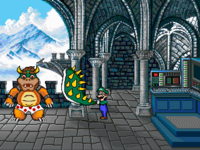
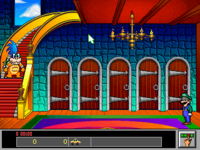
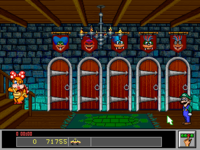
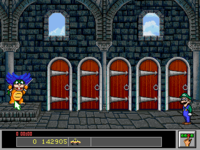

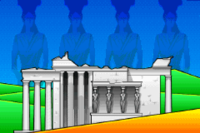
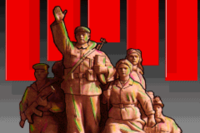
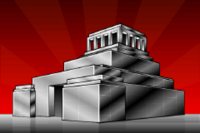

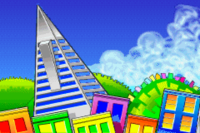

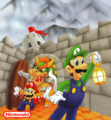
![Mario meeting Luigi in the PC version (scene by Dan Guerra[107])](https://mario.wiki.gallery/images/thumb/e/ef/Mario_is_Missing%21_Luigi_and_Mario_PC.jpg/120px-Mario_is_Missing%21_Luigi_and_Mario_PC.jpg)